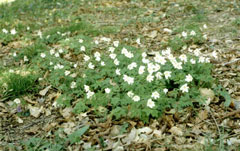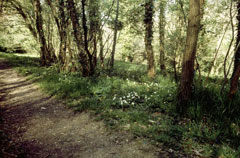 |
|
http://commons.wikimedia.org/wiki/File:Cleaned-Illustration_Anemone_nemorosa.jpg |
 |
| http://commons.wikimedia.org/wiki/User:Fabelfroh |
Translate this page:
Summary
Physical Characteristics

 Anemone nemorosa is a PERENNIAL growing to 0.2 m (0ft 8in) by 0.3 m (1ft) at a fast rate.
Anemone nemorosa is a PERENNIAL growing to 0.2 m (0ft 8in) by 0.3 m (1ft) at a fast rate.
See above for USDA hardiness. It is hardy to UK zone 5 and is not frost tender. It is in flower from March to May, and the seeds ripen from May to June. The species is hermaphrodite (has both male and female organs) and is pollinated by Bees, flies. The plant is self-fertile.
Suitable for: light (sandy), medium (loamy) and heavy (clay) soils. Suitable pH: mildly acid, neutral and basic (mildly alkaline) soils and can grow in very alkaline soils.
It can grow in full shade (deep woodland) semi-shade (light woodland) or no shade. It prefers dry or moist soil and can tolerate drought.
UK Hardiness Map
US Hardiness Map
Synonyms
Anemanthus nemorosus Fourr. Pulsatilla nemorosa Schrank. Ranunculus nemorosus Garsault [Invalid].
Plant Habitats
Woodland Garden Dappled Shade; Shady Edge; not Deep Shade; Meadow;
Edible Uses
References More on Edible Uses
Medicinal Uses
Plants For A Future can not take any responsibility for any adverse effects from the use of plants. Always seek advice from a professional before using a plant medicinally.
Antirheumatic Homeopathy Rubefacient Tonic
The leaves are antirheumatic, rubefacient and tonic[7, 19, 46]. The plant is sometimes used externally as a counter-irritant in the treatment of rheumatism[7]. The herb is gathered in spring before the plant comes into flower[7]. Various parts of this herb used to be recommended for a variety of complaints such as headaches and gout, though the plant is virtually not used nowadays[4]. A homeopathic remedy has been made from the leaves[7].
References More on Medicinal Uses
The Bookshop: Edible Plant Books
Our Latest books on Perennial Plants For Food Forests and Permaculture Gardens in paperback or digital formats.

Edible Tropical Plants
Food Forest Plants for Hotter Conditions: 250+ Plants For Tropical Food Forests & Permaculture Gardens.
More

Edible Temperate Plants
Plants for Your Food Forest: 500 Plants for Temperate Food Forests & Permaculture Gardens.
More

More Books
PFAF have eight books available in paperback and digital formats. Browse the shop for more information.
Shop Now
Other Uses
References More on Other Uses
Cultivation details
Prefers a moist soil[1, 90, 200] but tolerates dry conditions during its summer dormancy[200]. Plants tolerate dry conditions and drought so long as there is plenty of humus in the soil[190]. Prefers a well-drained humus-rich soil[200]. Dislikes very acid soils[13]. Prefers a shady position, growing well on woodland edges[24, 90], but plants can also be naturalized in thin turf[200]. Plants seem to be immune to the predations of rabbits[233]. A greedy plant, inhibiting the growth of nearby plants, especially legumes[54]. The plant has a running rootstock and can spread rapidly when well-sited[4]. A very ornamental plant[1], there are several named varieties[190].
References Carbon Farming Information and Carbon Sequestration Information
Temperature Converter
Type a value in the Celsius field to convert the value to Fahrenheit:
Fahrenheit:
The PFAF Bookshop
Plants For A Future have a number of books available in paperback and digital form. Book titles include Edible Plants, Edible Perennials, Edible Trees,Edible Shrubs, Woodland Gardening, and Temperate Food Forest Plants. Our new book is Food Forest Plants For Hotter Conditions (Tropical and Sub-Tropical).
Shop Now
Plant Propagation
Seed - best sown in a cold frame as soon as it is ripe in the summer[1]. Surface sow or only just cover the seed and keep the soil moist. Sow stored seed as soon as possible in late winter or early spring. The seed usually germinates in 1 - 6 months at 15°c[133]. When large enough to handle, prick the seedlings out into individual pots and grow them on in light shade in the greenhouse for at least their first year. When the plants are large enough, plant them out in the spring. Division in late summer after the plant dies down.
Other Names
If available other names are mentioned here
Native Range
EUROPE: Denmark, Finland, United Kingdom, Ireland, Norway, Sweden, Austria, Belgium, Switzerland, Czech Republic, Germany, Hungary, Netherlands, Poland, Slovakia, Russian Federation (European part), Belarus, Estonia, Lithuania, Latvia, Moldova, Ukraine (west), Albania, Bulgaria, Bosnia and Herzegovina, Greece (north), Croatia, Italy, North Macedonia, Montenegro, Romania, Serbia, Slovenia, Turkey (Istanbul, Kirklareli), Spain (north), France (incl. Corsica)
Weed Potential
Right plant wrong place. We are currently updating this section.
Please note that a plant may be invasive in one area but may not in your area so it's worth checking.
Conservation Status
IUCN Red List of Threatened Plants Status :

Growth: S = slow M = medium F = fast. Soil: L = light (sandy) M = medium H = heavy (clay). pH: A = acid N = neutral B = basic (alkaline). Shade: F = full shade S = semi-shade N = no shade. Moisture: D = dry M = Moist We = wet Wa = water.
Now available:
Food Forest Plants for Mediterranean Conditions
350+ Perennial Plants For Mediterranean and Drier Food Forests and Permaculture Gardens.
[Paperback and eBook]
This is the third in Plants For A Future's series of plant guides for food forests tailored to
specific climate zones. Following volumes on temperate and tropical ecosystems, this book focuses
on species suited to Mediterranean conditions—regions with hot, dry summers and cool, wet winters,
often facing the added challenge of climate change.
Read More
Expert comment
Author
L.
Botanical References
17200
Links / References
For a list of references used on this page please go here
Readers comment
© 2010, Plants For A Future. Plants For A Future is a charitable company limited by guarantee, registered in England and Wales. Charity No. 1057719, Company No. 3204567.